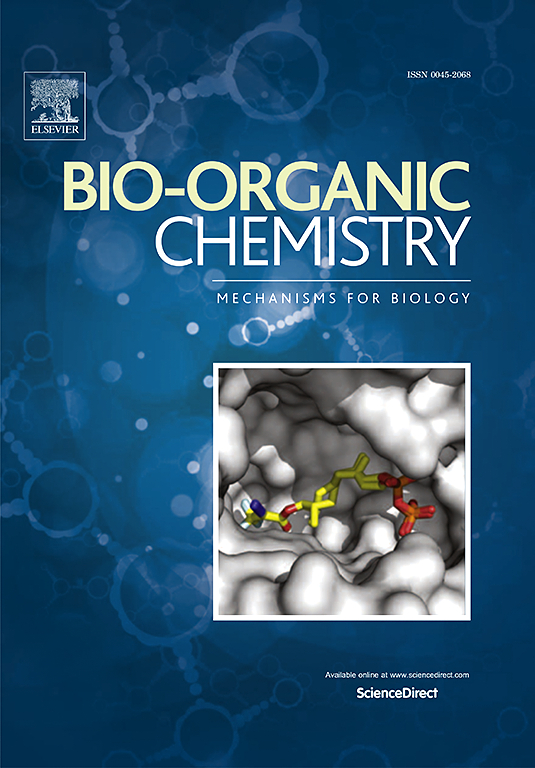中国食用菌甘巴君藏子实体中具有抗神经炎症活性的新型对苯
IF 4.5
2区 医学
Q1 BIOCHEMISTRY & MOLECULAR BIOLOGY
引用次数: 0
摘要
通过对著名食食菌甘巴君(Thelephora ganbajun)的乙酸乙酯提取物进行详细的真菌化学探索,分离出6个新的对terphenyl衍生物,命名为The eleganbanins a−F(1-6),以及5个已知的对terphenyl衍生物,分别是atromentin(7)、fendleryl B(8)、2- o - methyllatromentin(9)、vialinin B(10)和ganbajunin B(11)。通过全面的光谱分析,特别是一维和二维核磁共振数据和HRMS测量,精确地确定了它们的结构。通过单晶x射线衍射和计算与实验ECD谱的比较,进一步确定了化合物1-6的绝对构型。具有罕见α, β-不饱和-γ-丁内酯核的eleganbanins A(1)和B(2)首次在天然存在的对苯衍生物中通过醛醇缩合合成。结果表明,秀丽隐花霉素C(3)是一对具有1 ',6 ' -二氢-2 ',5 ' -吡啶二酮环的对三苯基对映体。eleganbanin D(4)是第一个含有半缩醛呋喃酮的对苯衍生物。对化合物1 ~ 2和4 ~ 10的抗神经炎活性进行了筛选。结果表明,这些化合物对脂多糖(LPS)诱导的BV-2小胶质细胞中促炎细胞因子TNF-α、IL-6和IL-1β的产生具有抑制活性。进一步研究表明,化合物2可以抑制JAK2/STAT3信号通路的磷酸化。这些发现表明,从食用菌甘巴君藏中提取的对terphenyl衍生物有望成为治疗神经炎症相关疾病的候选药物。本文章由计算机程序翻译,如有差异,请以英文原文为准。

Novel p-terphenyls with anti-neuroinflammatory activity from fruiting bodies of the Chinese edible mushroom Thelephora ganbajun Zang
The detailed mycochemical exploration of the EtOAc extract of a famous edible mushroom Thelephora ganbajun, resulted in the isolation of six new p-terphenyl derivatives, named theleganbanins A − F (1–6), together with five known ones, namely atromentin (7), fendleryl B (8), 2-O-methylatromentin (9), vialinin B (10), and ganbajunin B (11). Their structures were precisely determined through comprehensive spectroscopic analyses, especially 1D and 2D NMR data and HRMS measurement. Single crystal X-ray diffraction and comparison of calculated and experimental ECD spectra were conducted to further confirm the absolute configurations of compounds 1–6. Theleganbanins A (1) and B (2) featuring a rare α, β-unsaturated-γ-butyrolactone core were proposed to be biosynthesized through aldol condensation for the first time in naturally occurring p-terphenyl derivatives. Theleganbanin C (3) was identified as a pair of p-terphenyl enantiomers with a novel 1′, 6′-dyhydro-2′, 5′-pyridinedione ring. Theleganbanin D (4) was the first example of p-terphenyl derivatives with a hemiacetal furanone moiety. The anti-neuroinflammatory activities of compounds 1–2 and 4–10 were screened. As a result, these compounds showed inhibitory activity on the production of pro-inflammatory cytokines TNF-α, IL-6 and IL-1β in lipopolysaccharide (LPS)-induced BV-2 microglial cells. Further investigation showed that compound 2 could inhibit the phosphorylation of JAK2/STAT3 signaling pathway. These finding indicated that p-terphenyl derivatives from edible mushroom Thelephora ganbajun Zang would be promising drug candidates in treatment of neuroinflammatory related diseases.
求助全文
通过发布文献求助,成功后即可免费获取论文全文。
去求助
来源期刊

Bioorganic Chemistry
生物-生化与分子生物学
CiteScore
9.70
自引率
3.90%
发文量
679
审稿时长
31 days
期刊介绍:
Bioorganic Chemistry publishes research that addresses biological questions at the molecular level, using organic chemistry and principles of physical organic chemistry. The scope of the journal covers a range of topics at the organic chemistry-biology interface, including: enzyme catalysis, biotransformation and enzyme inhibition; nucleic acids chemistry; medicinal chemistry; natural product chemistry, natural product synthesis and natural product biosynthesis; antimicrobial agents; lipid and peptide chemistry; biophysical chemistry; biological probes; bio-orthogonal chemistry and biomimetic chemistry.
For manuscripts dealing with synthetic bioactive compounds, the Journal requires that the molecular target of the compounds described must be known, and must be demonstrated experimentally in the manuscript. For studies involving natural products, if the molecular target is unknown, some data beyond simple cell-based toxicity studies to provide insight into the mechanism of action is required. Studies supported by molecular docking are welcome, but must be supported by experimental data. The Journal does not consider manuscripts that are purely theoretical or computational in nature.
The Journal publishes regular articles, short communications and reviews. Reviews are normally invited by Editors or Editorial Board members. Authors of unsolicited reviews should first contact an Editor or Editorial Board member to determine whether the proposed article is within the scope of the Journal.
 求助内容:
求助内容: 应助结果提醒方式:
应助结果提醒方式:


